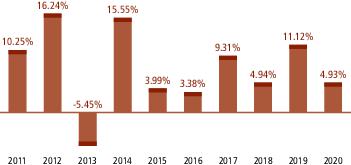Form 497K GOLDMAN SACHS TRUST
Summary
Prospectus
July 29, 2021
Goldman Sachs High Yield Municipal Fund
Class
A: GHYAX Class C: GHYCX Institutional: GHYIX Investor: GYIRX Class R6: GHYSX
Before you invest, you may want to review the Goldman Sachs
High Yield Municipal Fund (the “Fund”) Prospectus, which contains more information about the Fund and its risks. You can find the Fund’s Prospectus, reports to shareholders and other information about the Fund online at http://www.gsamfunds.com/mutualfunds. You can also get this information at no cost by calling 800-621-2550 for Institutional and Class R6 shareholders, 800-526-7384 for all other shareholders or by sending
an e-mail request to [email protected]. The Fund’s Prospectus and Statement of Additional Information (“SAI”), both dated July 29, 2021, are incorporated by reference into this Summary Prospectus.
Shareholder Fees
(fees paid directly from your
investment)
| Class A | Class C | Institutional | Investor | Class R6 | |
| Maximum Sales Charge (Load) Imposed on Purchases (as a percentage of offering price) | 4.50% | None | None | None | None |
| Maximum Deferred Sales Charge (Load) (as a percentage of the lower of original purchase price or sale proceeds)1 | None | 1.00% | None | None | None |
Annual Fund Operating
Expenses
(expenses that you pay each
year as a percentage of the value of your investment)
| Class A | Class C | Institutional | Investor | Class R6 | |
| Management Fees | 0.50% | 0.50% | 0.50% | 0.50% | 0.50% |
| Distribution and/or Service (12b-1) Fees | 0.25% | 0.75% | None | None | None |
| Other Expenses2 | 0.14% | 0.39% | 0.06% | 0.14% | 0.05% |
| Service Fees | None | 0.25% | None | None | None |
| Shareholder Administration Fees | None | None | None | None | None |
| All Other Expenses | 0.14% | 0.14% | 0.06% | 0.14% | 0.05% |
| Total Annual Fund Operating Expenses | 0.89% | 1.64% | 0.56% | 0.64% | 0.55% |
| Fee Waiver and Expense Limitation3 | (0.04)% | (0.04)% | (0.02)% | (0.04)% | (0.02)% |
| Total Annual Fund Operating Expenses After Fee Waiver and Expense Limitation | 0.85% | 1.60% | 0.54% | 0.60% | 0.53% |
| 1 | A contingent deferred sales charge (“CDSC”) of 1% is imposed on Class C Shares redeemed within 12 months of purchase. |
| 2 | The “Other Expenses” for Investor Class Shares have been restated to reflect expenses expected to be incurred during the current fiscal year. |
| 3 | The Investment Adviser has agreed to reduce or limit “Other Expenses” (excluding acquired fund fees and expenses, transfer agency fees and expenses, service fees, taxes, interest, brokerage fees, expenses of shareholder meetings, litigation and indemnification, and extraordinary expenses) to 0.004% of the Fund’s average daily net assets. Additionally, Goldman Sachs & Co. LLC (“Goldman Sachs”), the Fund’s transfer agent, has agreed to waive a portion of its transfer agency fee (a component of “Other Expenses”) equal to 0.02% as an annual percentage rate of the average daily net assets attributable to Class A, Class C and Investor Shares of the Fund. These arrangements will remain in effect through at least July 29, 2022, and prior to such date, the Investment Adviser and Goldman Sachs may not terminate the arrangements without the approval of the Board of Trustees. |
2 Summary
Prospectus — Goldman Sachs High Yield Municipal Fund
3 Summary
Prospectus — Goldman Sachs High Yield Municipal Fund
4 Summary
Prospectus — Goldman Sachs High Yield Municipal Fund
TFFISUM1-21
Serious News for Serious Traders! Try StreetInsider.com Premium Free!
You May Also Be Interested In
- Infosys Q4 Earnings: Profit Jumps 30% YoY, Goldman Sachs Cuts TP
- Infosys Technologies (INFY) PT Lowered to $19.90 at Goldman Sachs
- Netflix subscribers, oil prices, Bitcoin volatility - what's moving markets
Create E-mail Alert Related Categories
SEC FilingsRelated Entities
Goldman SachsSign up for StreetInsider Free!
Receive full access to all new and archived articles, unlimited portfolio tracking, e-mail alerts, custom newswires and RSS feeds - and more!



 Tweet
Tweet Share
Share
